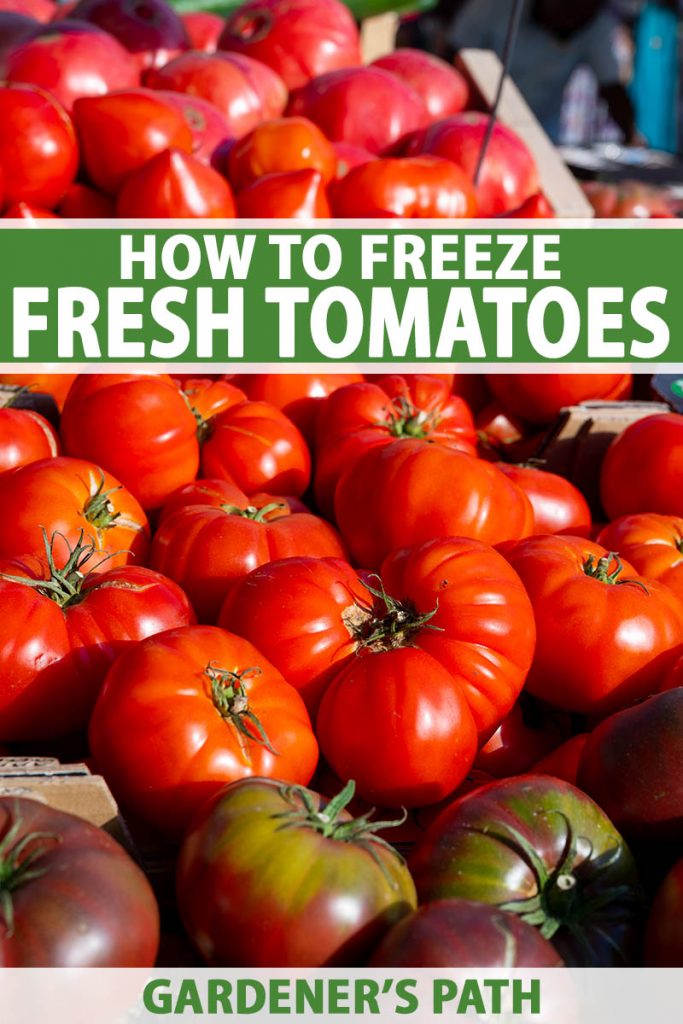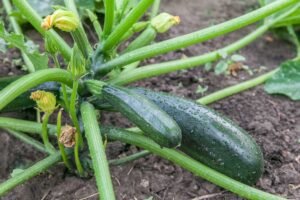Can you freeze fresh tomatoes? Short answer: sure.
But this is one of those times when you should hold out for the long answer.
While it’s technically possible to stash homegrown produce in your cold storage appliance until it can hold no more, there are often better options for preserving a glut of tomatoes.
I’m not going to hold back with my advice on this matter. I have opinions – strong opinions, which I’ve formed over many years of being a gardener, cook, food preserver, and frugal-but-generous person.
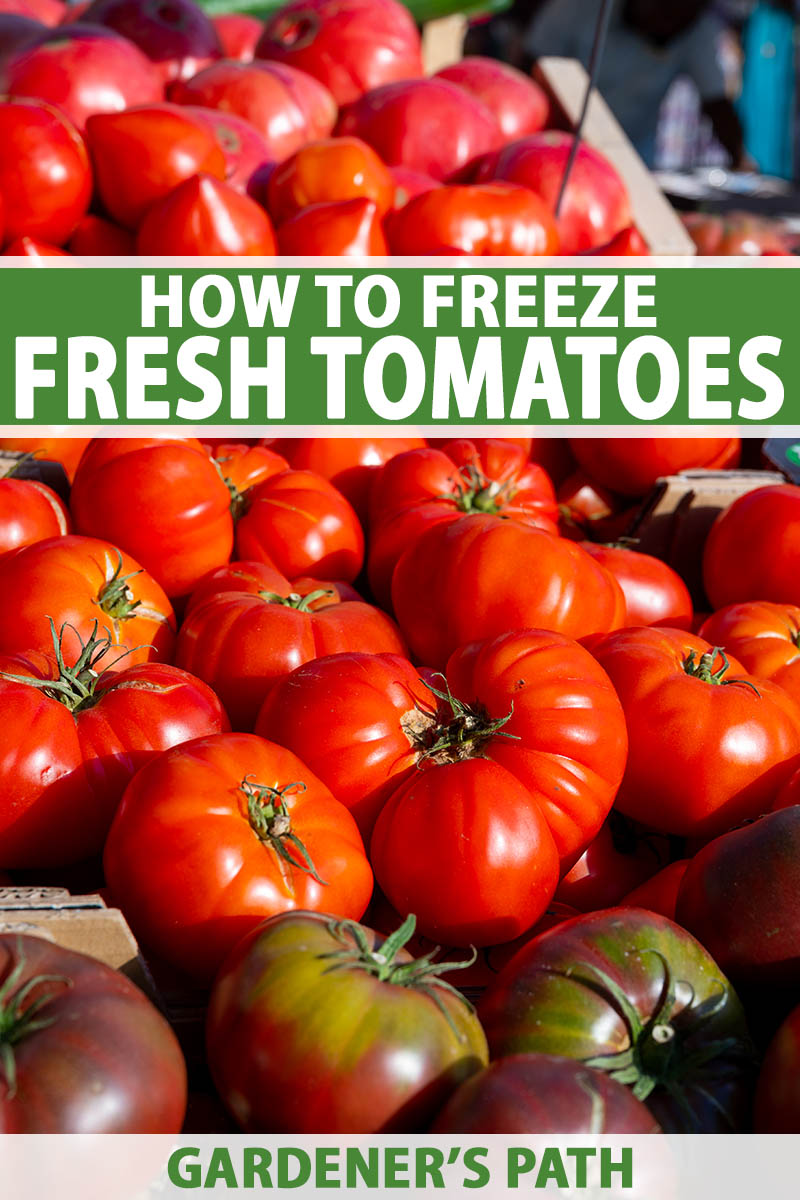
We link to vendors to help you find relevant products. If you buy from one of our links, we may earn a commission.
I will try not to be overbearing. But I’m also not going to let you banish excellent produce to the icy depths of that overflow chest freezer in the basement if you won’t ever use it to cook with in the future.
And I will do my best to steer you away from the rookie mistake of “putting up” countless pounds of cut-up giant fruits that you’ll never use, when you could instead focus on making tasty jams or salsas that you’ll actually look forward to eating in the future.
I’ll start with the fresh-to-freezer basics, because there are times when that’s your best option.
Let’s get going – those ripe beauties aren’t going to take care of themselves! Here’s what I’ll cover:
What You’ll Learn
Drawbacks and Advantages
There’s a reason home cooks and gardeners get excited about a home canning session for sauce or salsa, but don’t work up much enthusiasm for freezing their surplus:
While you can freeze fresh tomatoes, it changes their texture. When you defrost them, they’re pretty mushy, and may be rather watery, too.

There are substantial advantages to this way of saving extra produce, though. For one thing, it’s quite easy.
No canning jars or vats of boiling water required, nor pressure canners. Plus, no slaving over a hot stove!
And unlike the water-bath versions of canned sauces, if you’re planning to put fresh heirlooms or Romas into the deep freeze, you don’t have to worry about balancing the acid content to assure a safe seal.
If you want to add a bunch of garlic, onions, herbs, or even oils, you’re free to do so.
The crushing disadvantage to this method of saving that taste of summer is the texture.
When you work with big pieces of larger tomatoes with the skins on and the seeds still inside, the thawed result is usually limp and mushy. It’s typically fit only for soup or stew, or maybe to add to taco filling in small quantities.
When you’re considering going this route, I strongly advise you to figure out ahead of time just how many plain tomatoes you use in ordinary cooking, and how many more you could incorporate.
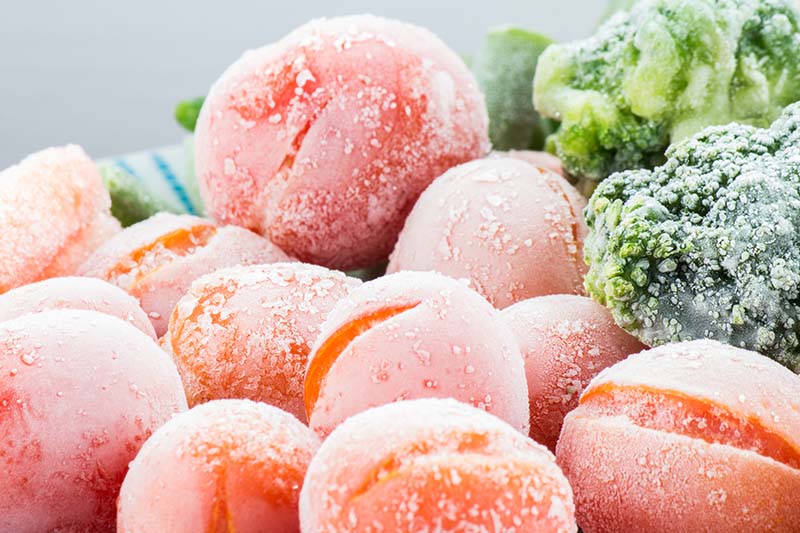
If you make chili a couple of times a year, and maybe add tomatoes to a jambalaya or seafood dish on occasion, it’s fine to stash a handful of one- or two-cup packets in the old icebox.
But unless you are going to cook with thawed tomato pieces every week, stop there. Oh, you can still provide yourself with plenty of them for cooking, but gussy them up a little bit before they hit the storage shelves for the winter.
I’ll share some good fresh-to-freezer strategies here in a second, along with directing you to our sister site, Foodal, for a darn useful method of making both concasse and pico de gallo with your bounty.
But first, a warning: Sometimes you just shouldn’t freeze your haul.
Close that appliance door, put the chopping knife away, and head to the food bank or the compost pile with your extras instead. Read on and please heed my advice to save time, money, and space.
Fresh Tomatoes You Should Never Freeze
While it may seem like a speedy solution to a pressing problem, there are many times when you should just forget about trying to deal with a surplus via the icebox.
Right up front, I will mention any store-bought varieties that aren’t grown locally or labeled as heirlooms.
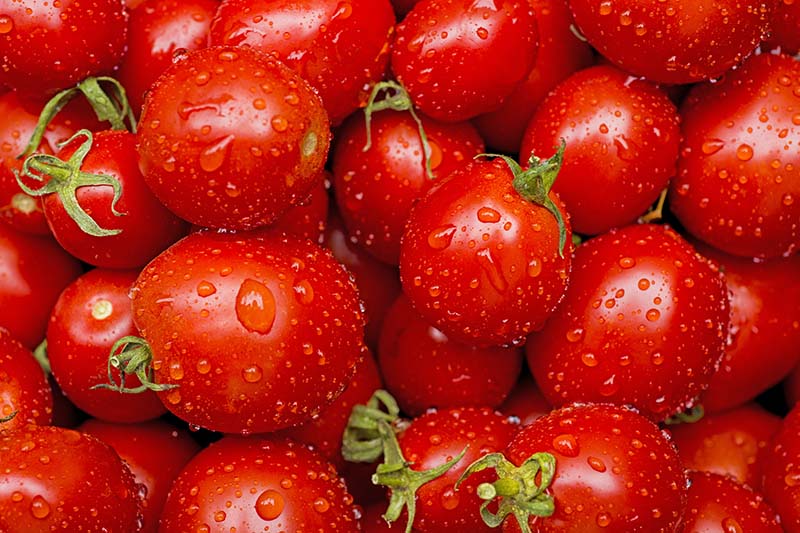
Larger varieties hybridized to survive storage and transport between farm (or hothouse) and market don’t usually have enough taste to warrant saving.
You’ll pretty much end up with mushy chunks you’ll probably never add to a recipe, so why waste the storage space?
That store-bought produce is only meant to add a bit of tomato to your salad or sandwich, not to provide delicious ingredients for substantial meals in busy or lean times to come.
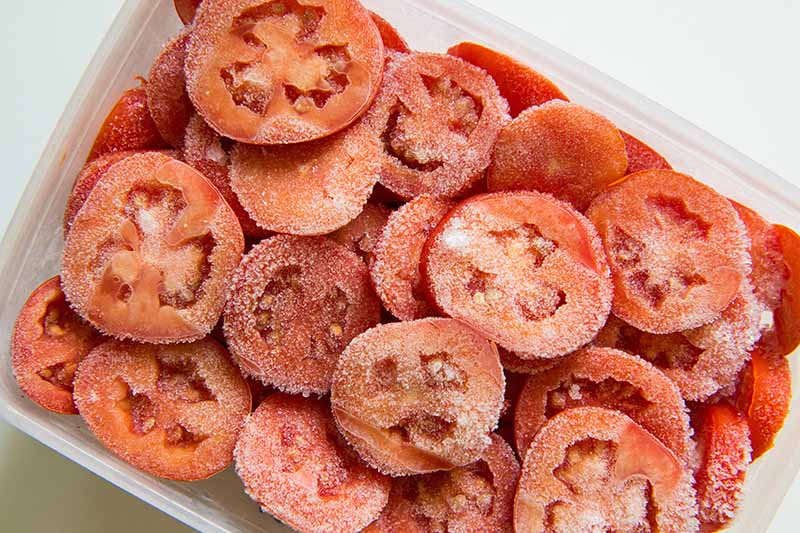
The grape varieties that growers ship all over the world also tend to have pretty tough skins, which do not have a desirable taste or texture after defrosting.
Nor will the thawed versions melt into slow-cooked sauce. Instead, they’ll maintain the consistency of, say, small bits of cooked apple peel. (I know this from the school of Live and Learn.)
With any tomatoes you grow yourself, though, you still have a fighting chance of getting a few decent packs stashed away to use in future stews and sauces.
Even homegrown “slicing” varieties, or beefsteaks, will do okay just cored, cut into pieces, and frozen with their skins on. But I would never recommend trying to preserve a big box or bucket of them.
Instead, only make the effort in this case as an absolute last resort. In my opinion, there just aren’t enough appealing ways to work them into your cooking routine.
I’d encourage you to do a little extra chopping, squeezing, and peeling, or maybe even a little cooking for any beefsteak-type surplus. And maybe add a few extra ingredients before stashing them away.
That way, you’ll have a sauce or salsa, or even a jam, waiting for you to defrost and enjoy in the future.
It will be something to look forward to!
If you do want to “put up” a big batch and you’re going to buy produce, try to pick the heavy-fleshed, Italian “sauce” tomatoes or other paste varieties that are ideal for canning.
Those will produce the meatiest texture and the most robust taste, whether you just stash them as is, skins and all, or roast, puree, or reduce them to a glorious, jammy concoction first.
Cherry and Grape Tomatoes
I’m not saying to buy out the farmers market just for the purpose of making these.
But it’s convenient and beneficial to flash-freeze tiny tomatoes, as long as they passed the “not sold in chain groceries from growers who live far, far away” test.
I learned this method from the “Food In Jars” cookbook by Marisa McClellan, available from Amazon, and I was astonished at how simply it works.

Food in Jars: Preserving in Small Batches Year-Round
Basically, you wash the cherry, grape, or currant varieties in question and set them aside on a clean towel until the skins are dry.
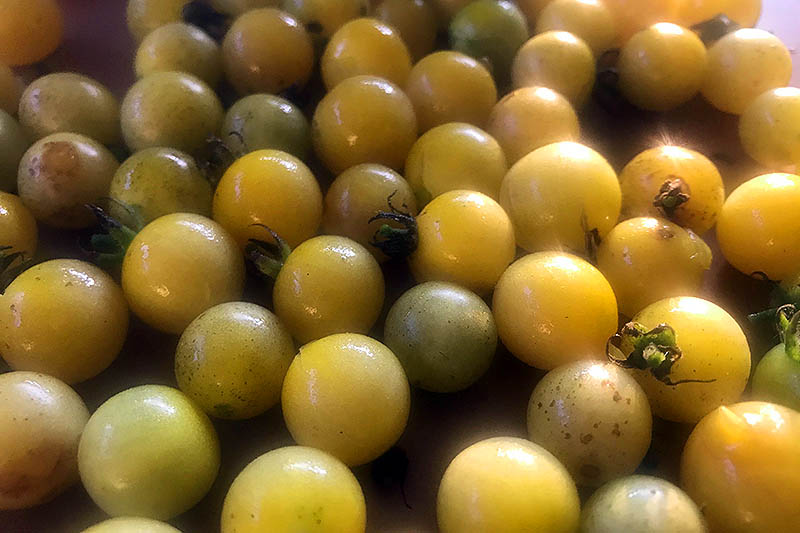
Then put them on a super-clean rimmed baking sheet. (I’ve even used a rimmed serving tray in a pinch.) Pop the sheet in the icebox and leave it there until the fruits are frozen.
If I’m in a hurry, I leave the little green tops on. If I’ve got an extra minute, I pop them off during this step to save time when I’m ready to cook them.
Just remember: they’ve got to come off at some point before cooking!
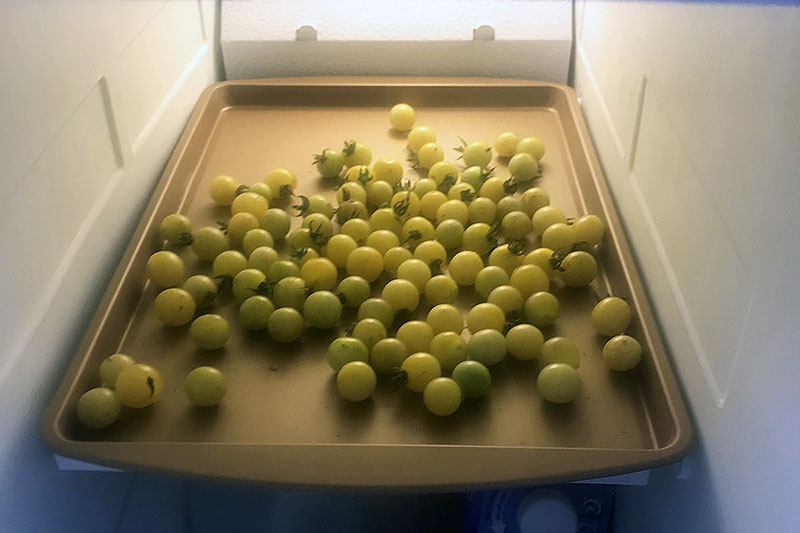
Use a funnel or spoon to place the orbs into a freezer-safe small jar with a screw-on lid.
Or, you can place them in freezer-safe stackable BPA-free storage containers like those from the Brilliance collection made by Rubbermaid, available on Amazon.

Rubbermaid Freezer-Safe Storage Containers
That’s it! You can add what you need directly into a boiling soup or stew, while they’re still in a frozen state.
Or you can also thaw them in the fridge overnight to add to a vegetable-egg scramble, or to add to the slow cooker along with a pot roast and veggies.
I’ve also had good luck storing the tiny frozen fruits in gallon-size bags to lay flat and stack, which can be a real space saver.
As long as they’re frozen solid when you put them into your container of choice, you’ll be in good shape. If they’re not, they’ll stick together.
Beefsteak or Slicer Method
You can use the same strategy for larger tomatoes, even oversize ‘Mr. Stripeys’ or ‘Big Boys.’ You will want to core them first, though.
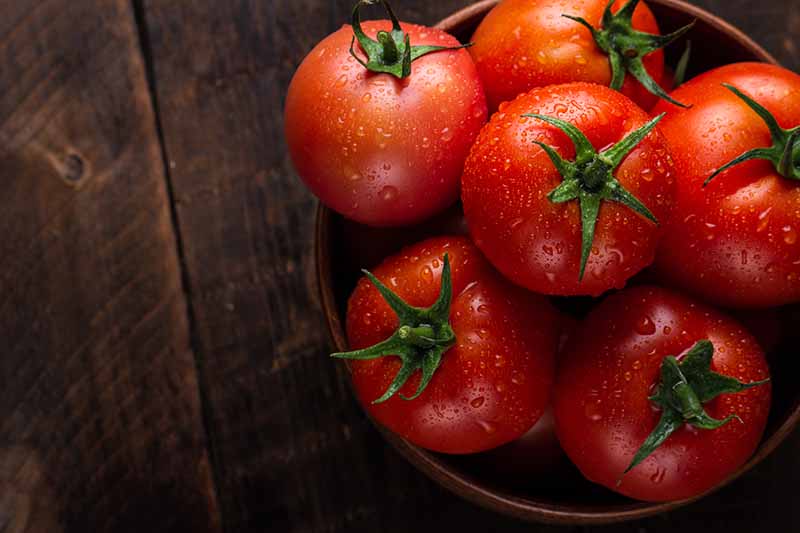
And you can leave the skins on, and cut them up into chunks first – or not, as you wish.
But don’t expect the thawed product to be ready to serve as a side dish. When you defrost frozen fresh tomatoes, they tend to be a bit mushy.
They’re not fancy, but you can add them to a slow-simmered homemade vegetable soup, or use them sparingly in chili.
You’ll definitely need to take a few more steps to turn them into something that will add flavor and have a good texture, though.
If you’re willing to put in a bit more work, you can freeze fresh tomatoes in a chopped, seeded, peeled form that lends itself to many delicious dishes.
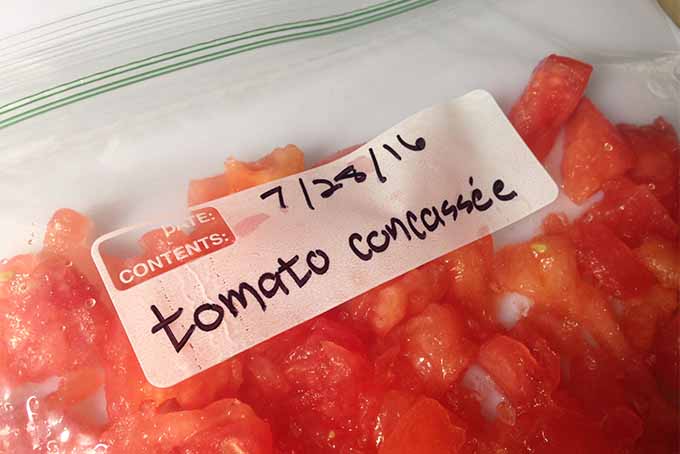
More extensive directions for this method, called concasse, are waiting for you on our sister site, Foodal.
Basically, it involves blanching the ripe fruits in boiling water for 30 seconds and then transferring them to an ice bath for about five minutes to stop the cooking process.
When they have cooled, it’s pretty easy to slip off the skins.
Next, you’ll squeeze out the seeds and juice, which eliminates much of the water that can make them taste a bit blah when you defrost them. This really improves the texture!
And before you store the blanched fruits, you first cut them into a convenient size for whatever you like to cook the most. Think bruschetta, or salsa, or maybe omelets – each requires a different size chop, so be sure to label them accordingly when you pack them away.
I’m all for concasse, because it is worth the effort to have more fully prepared, tastier ‘maters to thaw throughout the winter months.
Alternatively, you can also follow the blanching and ice bath method described above and then simply remove the skin and stem core and freeze them whole before transferring to freezer bags or containers.
But I will interject another opinion here. I can’t resist, and if you knew me better you wouldn’t expect me to…
I feel like if you’re willing to go to all the trouble to blanch and squeeze and chop, you might as well go a little further and make something you can reheat and eat right after thawing.
Read on for two more suggestions that are easy-peasy.
No-Cook Icebox Salsa
If you’re going to pick a bunch of fruits, yield counter space to them, and unpack the knives and cutting board, the way I see it, you might as well get out the blender and make some salsa.

That way, many weeks or months later, you can just defrost and proceed with making your nachos or whatnot.
I like this recipe for blender salsa, which I adapted from another favorite Marisa McClellan work, “Preserving by the Pint,” available on Amazon.

Preserving by the Pint: Quick Seasonal Canning for Small Spaces
Basically, the difference between her recipe and mine is that I’m not willing to peel or simmer the tomatoes, or seed a hot pepper, and she is. I say, skip the extra labor!
Here’s what you do to yield four cups total:
1. Place the following in a blender or food processor:
- 4 cups cored, chopped tomato
- 1/2 cup minced onion
- 2 chopped garlic cloves
- 1 roughly chopped jalapeno or hot banana pepper
- 2 tablespoons fresh lime juice or white balsamic vinegar
- Zest of one lime
- 1 tablespoon flake or kosher salt
- Chili powder or cayenne pepper, to taste (optional)
2. Process it until the mixture has the texture of your favorite salsa. Sample a bit and add more salt if needed, plus chili powder or cayenne to taste.
3. Divide it into small containers and place them in the icebox. Be sure to leave at least an inch of space at the top – the salsa will expand at low temperatures.
When you’re ready to eat it, let it defrost in the fridge for eight to 10 hours. Stir and serve.
This is also a good chili or vegetable soup addition if you’re out of canned sauce. (I, for one, am always out of canned sauce!)
If you want to get really fancy, feel free to bring the thawed salsa to a boil and then reduce the heat and simmer it for five minutes, as per the original recipe.
Don’t have time or the ingredients for this? I suggest making the tomato-salt-vinegar part, freezing, and then adding the other stuff and giving it another whirr in the blender after you defrost it.
Freezer Tomato Jam
If you haven’t ventured into the wonderful world of freezer jams, that extra bushel of soon-to-rot red veggies is a great excuse to start.

Our sister site, Foodal, covers all you need to know about the different ways to make jams and jellies. They really make it straightforward!
And this recipe for tomato jam, also from Foodal, is an excellent option for freezing.
If you like those types of cooking projects, the following recipe is another great choice for preserving that bumper crop a cup at a time.
It will keep frozen for up to a year, and is super tasty on bruschetta, in omelets, and, dare I say it – slathered on hot biscuits!
This version also comes from “Preserving by the Pint,” but I’ll give you the short version:
- Wash a pint of farmers market or garden variety grape tomatoes and place them on a rimmed baking sheet with eight peeled garlic cloves.
- Sprinkle the veggies with a couple of teaspoons of dried thyme and a teaspoon of flake or kosher salt.
- Drizzle all with two tablespoons of olive oil.
- Bake for 20-25 minutes in a preheated 300˚F oven.
- Process the tender roasted mix in a food processor or blender until it is the consistency of chunky peanut butter.
- Scrape it into a half-pint jar or container.
- Cover with a thin layer of olive oil and then a lid and pop it in the freezer. Defrost overnight in the refrigerator before using.
If you’ve got more than a pint of extra cherry or grape tomatoes, you can double or triple the recipe.
But make sure you save it in the one-cup portions. That’s just enough for a tasty addition to a couple of special meals, without it being so much you feel like you are struggling to serve it at every meal.
And it’s the perfect size for sharing with a friend or bringing as a host gift.
Use ‘Em Up
Did I wait this long to tell you you may not even need to freeze that overflow? Yes, yes I did.
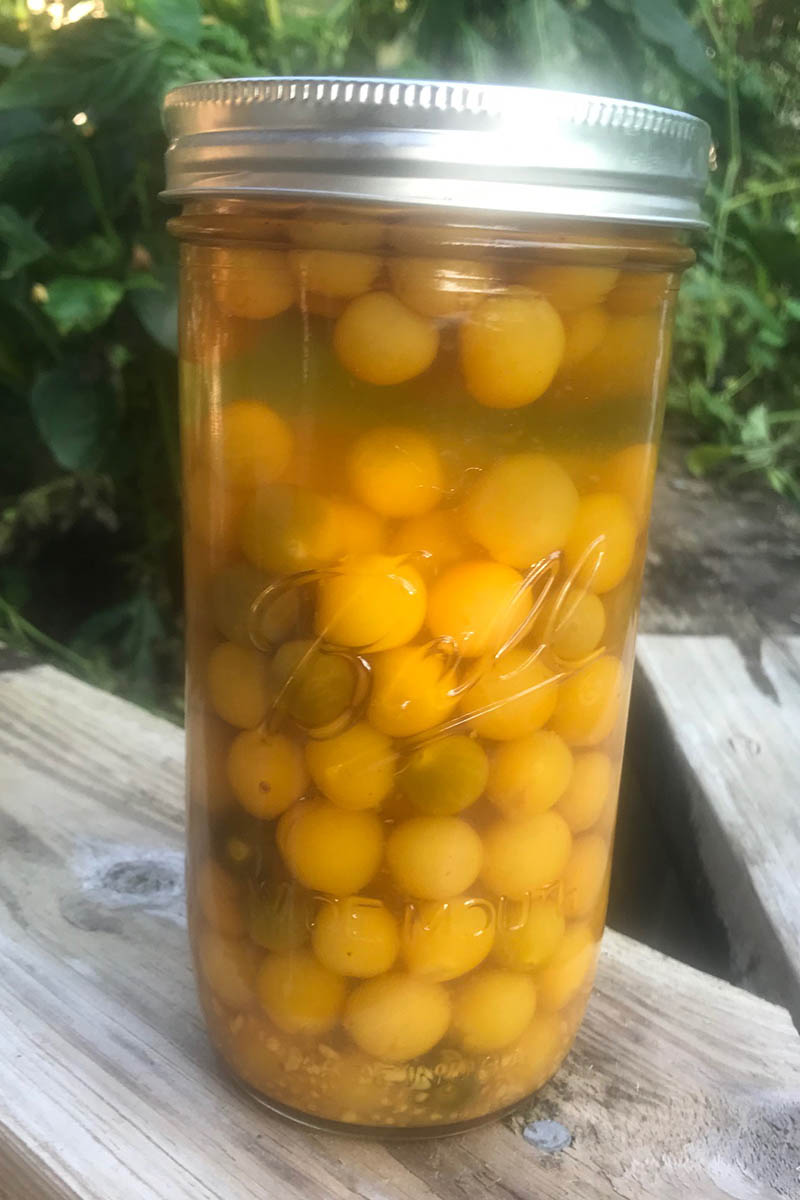
But only because I wanted you to know that you have lots of great options, without making you feel depressed if you’ve already let things go so far that wildly slinging jars and bags of whole frozen fruits has become your only option.
If that ripening heap hasn’t reached critical mass, there are other ways to contend with a bumper crop.
First and simplest is to make a really good fresh salsa recipe. There are more than a couple of good options on our sister site, Foodal. You have my permission to skip the blanching and peeling if that will make this more manageable.
Make a huge bowl. Be sure to eat it with chips, on eggs, and in omelets. Host a party and serve it. Freeze some, if you wish.
Make another big bowl, only this time stir in diced red onion, a bit of hot sauce, and a couple of cups of chopped seedless cucumbers at the end.
Presto, you’ve got gazpacho! Ready to sip from small cups during happy hour, or to eat with gusto at that long overdue lunch date you’ve been planning.
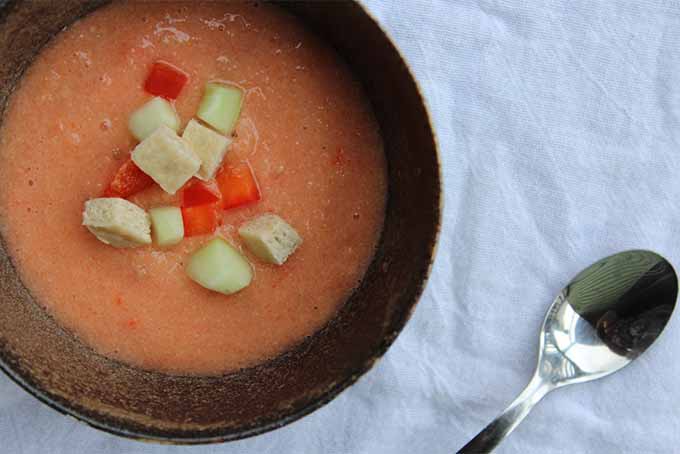
For something just a little fancier, try this version from Foodal.
Not feeling it with the cooking projects? Remember, local churches or charities that feed the hungry may be seeking some fresh ingredients.
Ample Harvest can help you to find a local organization that is taking fresh food donations. Make sure to call or email for an okay before you descend with your boxes of ripening produce, though.
If you’ve got grape or cherry varieties coming out of your ears, you can also make them into delicious refrigerator pickles.
I use a variation on a recipe from “The All New Ball Book Of Canning And Preserving” for that. You can find this book on Amazon.
Basically, it involves these steps:
- Make a brine by bringing two cups of white vinegar, one cup of water, two tablespoons of cane sugar, one tablespoon of pickling salt, two tablespoons of minced fresh basil, four crushed garlic cloves, two slices of lemon, and a large bay leaf to a boil.
- Reduce the heat and let the brine simmer for three minutes, giving it a good stir to dissolve the salt and sugar.
- Pack about four cups of cherry or grape tomatoes in a one-quart canning jar, then use a funnel to fill the jar with hot brine to a half inch from the top.
- Cover the jar with either a canning lid and ring (not too tight!) or a threaded plastic lid sold for this purpose.
- Let it come to room temperature.
Next comes the hard part:
When you place this concoction in the refrigerator, you have to wait one whole month for the flavors to meld! Then it’s game on for pickles that are super tasty on a tray of appetizers or as a garnish for Bloody Marys.
And you can use the brine as the vinegar in your favorite homemade vinaigrette.
Better Luck Next Year
Once you make it through this season and actually use up all your excess ‘maters, and then proceed to cook all your frozen goodies and have space amidst the ice cream once more, I implore you to pause and evaluate.
Are there ways you could avoid having to go through all this again? You bet there are, and they aren’t that tough.
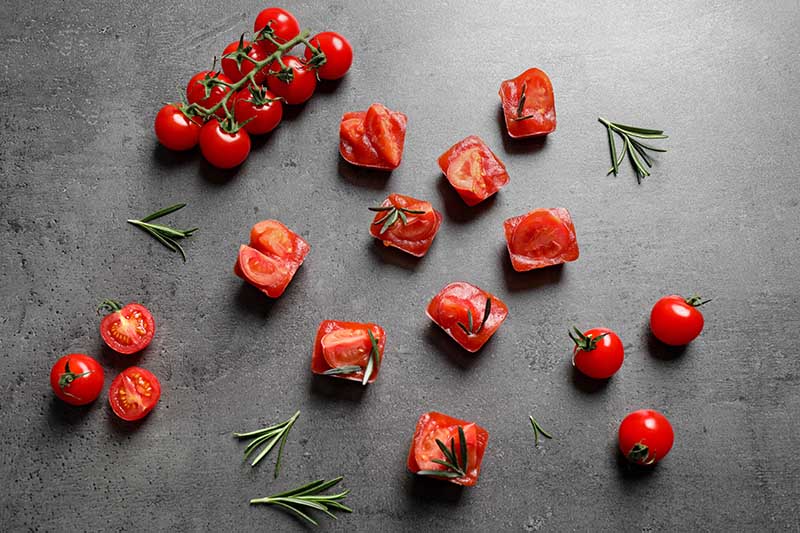
My first gentle suggestion:
Consider growing more determinant tomatoes, and make sure they’re varieties suitable for canning.
Determinants tend to fruit over the course of a couple of weeks, not months. That means you can pick them all at once and make huge batches of delicious marinara to freeze, or use a water bath to can dozens of jars of salsa all at once.
That way, you will be planning ahead for a bumper crop and can schedule the stocking up, instead of panicking late in the season when there are so many!
And be sure to check out our guide to growing tomatoes to get started.
There’s also something to be said for carefully choosing a CSA so that you receive plenty of slicers from local farms each week, but also a fair percentage of the varieties you can cook with throughout the season.
Just ask! Most growers are happy to balance your share with more of the type of produce you can use easily if you choose to sign up for one of these locally.
And I know this is another pretty strong opinion, but I would urge you to try to grow your own stuff when you can, and buy locally (and seasonally) when you can’t.
When you support sustainable growing methods, you’ll almost always be able to can, freeze, dehydrate, or store any of your extras.
Elsa’s Favorite Salad?
At the end of the day, I feel like anyone who has a surplus of this home garden favorite is fortunate indeed.
Isn’t it wonderful to be able to experiment with different ways to save your surplus, and then see which ones work best for your meal planning and preferred taste profiles?
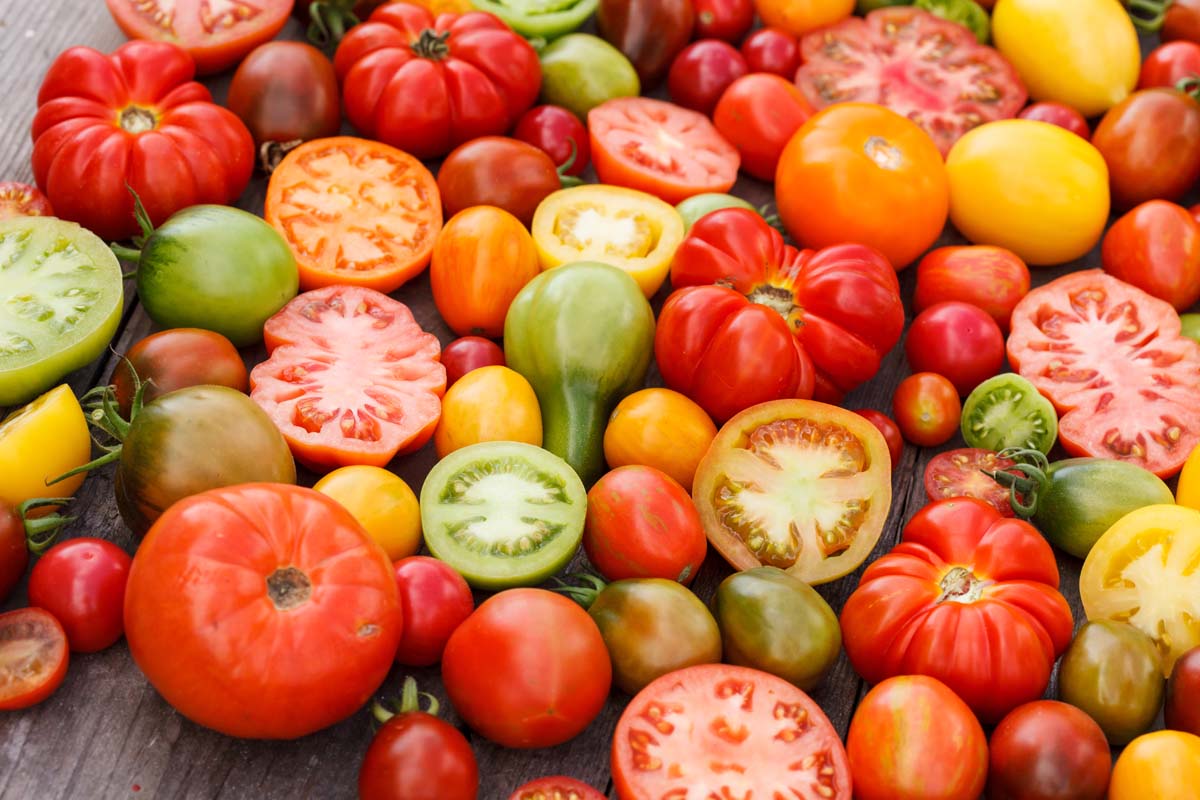
Speaking of personal taste, if you have your own favorite methods for preserving beefsteak, Roma, cherry, grape, or currant tomatoes, let’s have them!
Join the conversation in the comments section below, and remember, photos are always a welcome addition.
And you can learn more about growing tomatoes in the home garden by reading these articles next:
